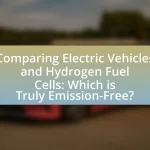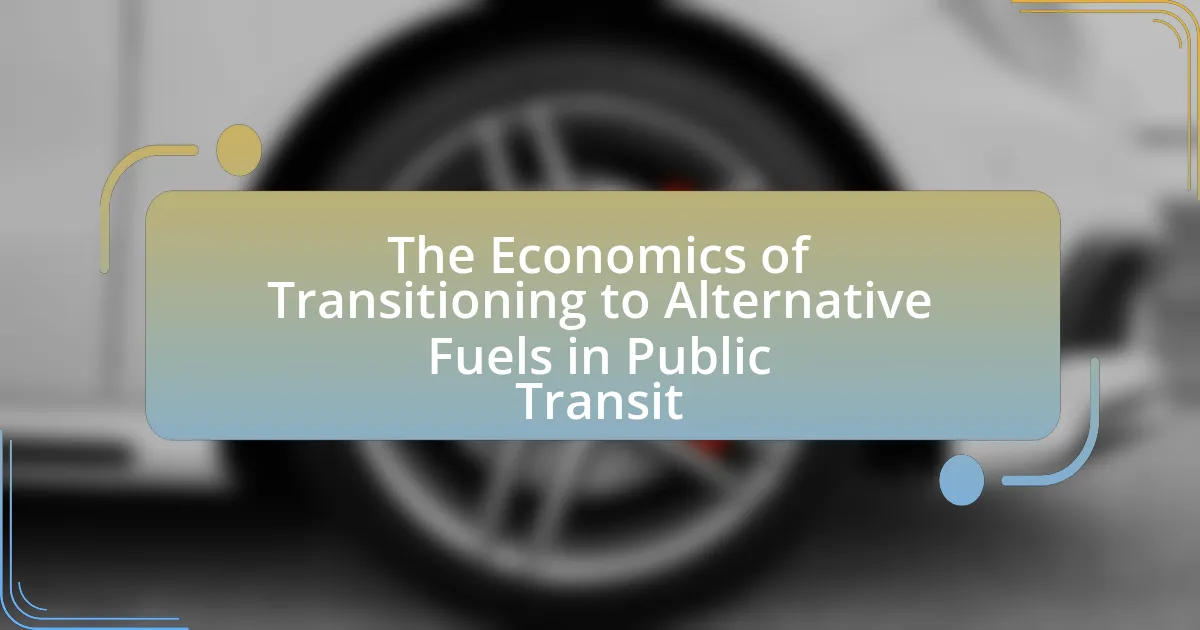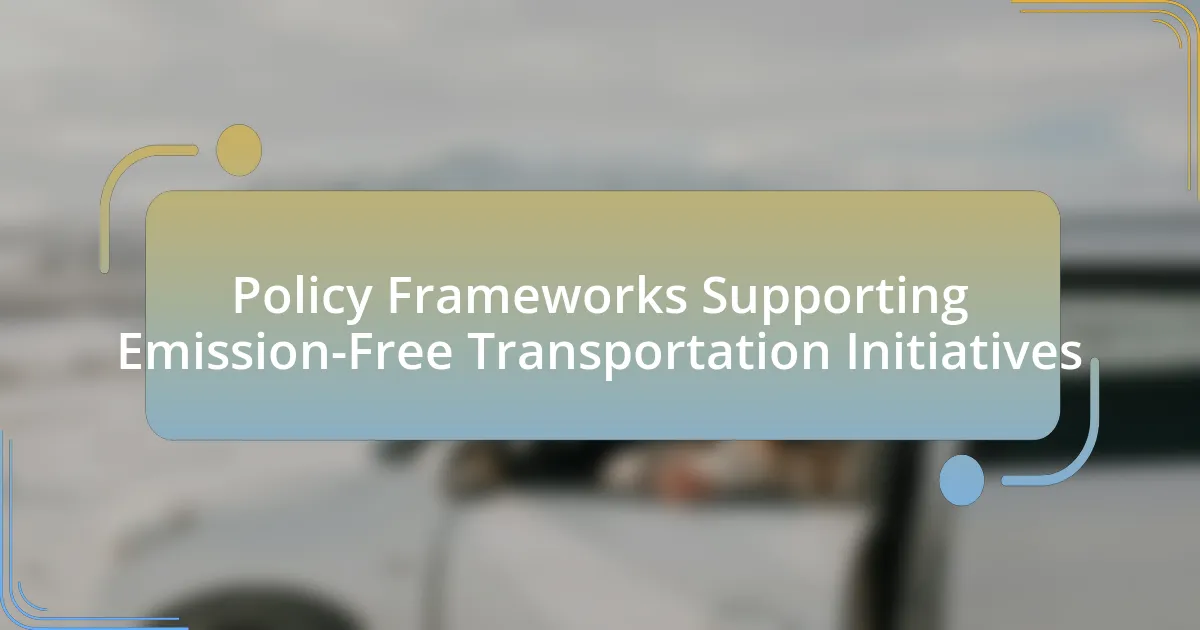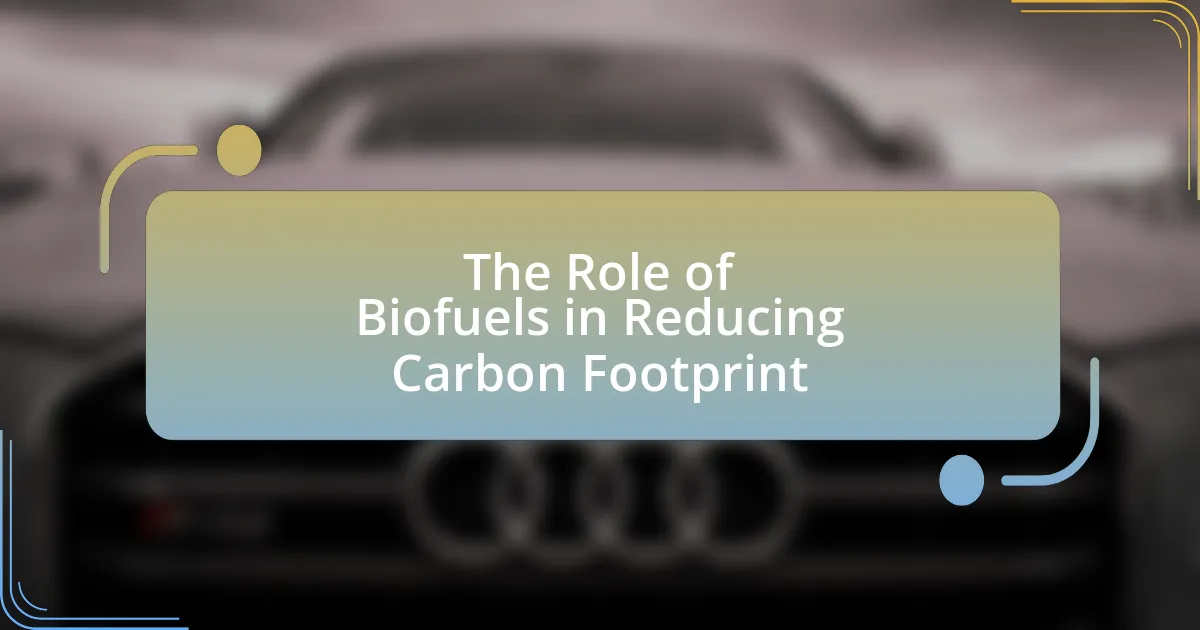Electric vehicles (EVs) and hydrogen vehicles (HVs) represent two distinct approaches to sustainable transportation, each with unique technologies and operational mechanisms. EVs utilize electric motors powered by rechargeable batteries, achieving high energy efficiency and zero tailpipe emissions, while hydrogen vehicles rely on fuel cells that convert hydrogen gas into electricity, emitting only water vapor. This article provides a comparative analysis of both vehicle types, discussing their operational principles, key components, advantages, disadvantages, and the challenges they face in terms of infrastructure, cost, and technology. Additionally, it examines future trends, government policies, and considerations for consumers when choosing between EVs and HVs, highlighting the evolving landscape of the automotive industry towards sustainability.
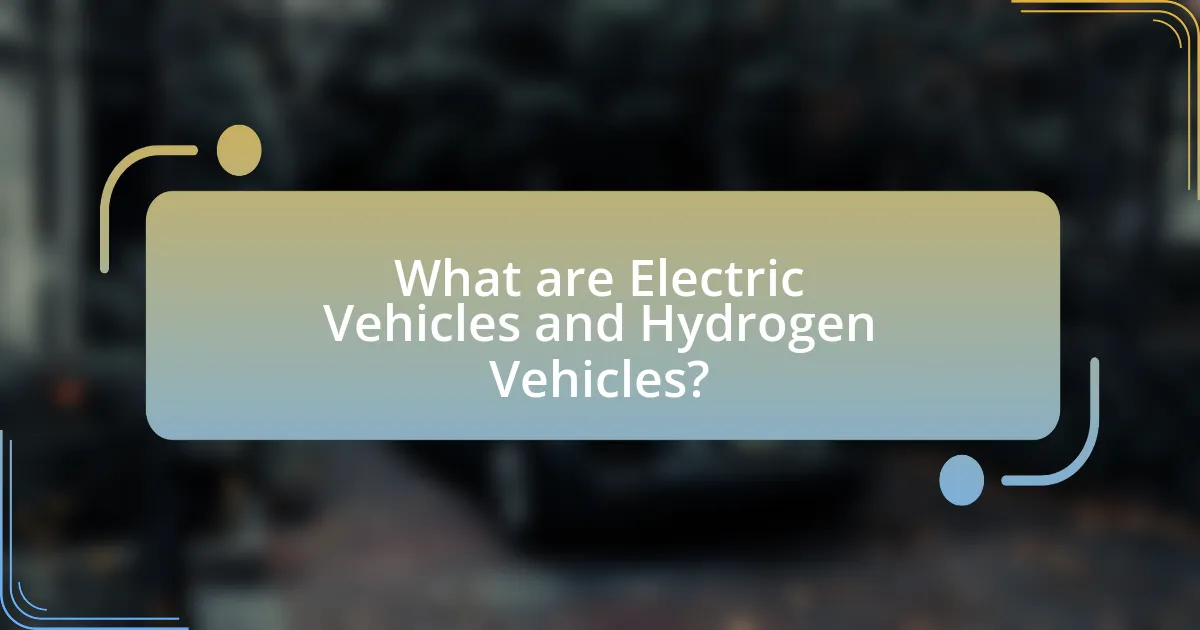
What are Electric Vehicles and Hydrogen Vehicles?
Electric vehicles (EVs) are automobiles that are powered entirely or partially by electricity, utilizing electric motors and batteries for propulsion. In contrast, hydrogen vehicles, also known as hydrogen fuel cell vehicles (FCVs), use hydrogen gas to power an electric motor through a chemical reaction in a fuel cell. EVs are characterized by their reliance on battery technology, while hydrogen vehicles depend on hydrogen production, storage, and fuel cell technology. According to the International Energy Agency, as of 2021, there were over 10 million electric cars on the road globally, demonstrating the growing adoption of EVs, while hydrogen vehicles remain less common, with approximately 25,000 units sold worldwide by the same year.
How do Electric Vehicles operate?
Electric vehicles operate by using electric motors powered by rechargeable batteries. The electric motor converts electrical energy into mechanical energy, propelling the vehicle. The batteries store energy, which is replenished through charging stations or home charging systems. According to the U.S. Department of Energy, electric vehicles can achieve efficiencies of around 60% to 77% in converting energy from the grid to power at the wheels, significantly higher than traditional internal combustion engines.
What are the key components of Electric Vehicles?
The key components of Electric Vehicles (EVs) include the electric motor, battery pack, power electronics, and regenerative braking system. The electric motor converts electrical energy into mechanical energy to drive the vehicle, while the battery pack stores the energy needed for operation, typically using lithium-ion technology. Power electronics manage the flow of electrical energy between the battery and the motor, ensuring efficient operation. The regenerative braking system captures energy during braking and feeds it back into the battery, enhancing overall efficiency. These components work together to provide a sustainable and efficient alternative to traditional internal combustion engine vehicles.
How do Electric Vehicles convert energy into motion?
Electric vehicles convert energy into motion through electric motors that utilize electrical energy stored in batteries. The process begins when the vehicle’s battery supplies direct current (DC) electricity to the electric motor. This electricity energizes the motor’s windings, creating a magnetic field that interacts with permanent magnets or other windings, resulting in rotational motion.
The efficiency of this conversion is high, with electric motors typically achieving over 90% efficiency in converting electrical energy to mechanical energy. This is supported by data from the U.S. Department of Energy, which indicates that electric vehicles can convert about 60% of the electrical energy from the grid to power at the wheels, compared to only about 20% for conventional gasoline vehicles.
How do Hydrogen Vehicles function?
Hydrogen vehicles function by converting hydrogen gas into electricity through a process called electrochemical reaction in a fuel cell. In this process, hydrogen gas is fed into the fuel cell, where it reacts with oxygen from the air. This reaction produces electricity, water, and heat. The electricity generated powers an electric motor, which drives the vehicle. Hydrogen vehicles typically have a hydrogen storage tank that holds the gas under high pressure, allowing for efficient energy storage and quick refueling, similar to conventional gasoline vehicles. This technology enables hydrogen vehicles to achieve longer ranges and faster refueling times compared to battery electric vehicles.
What are the essential parts of Hydrogen Vehicles?
The essential parts of hydrogen vehicles include the hydrogen fuel tank, fuel cell stack, electric motor, power electronics, and battery system. The hydrogen fuel tank stores hydrogen gas under high pressure, enabling efficient energy storage. The fuel cell stack converts hydrogen into electricity through an electrochemical reaction, providing power to the electric motor. The electric motor drives the vehicle, while the power electronics manage the flow of electricity between the fuel cell, motor, and battery system. The battery system stores excess energy and provides additional power during acceleration. These components work together to enable hydrogen vehicles to operate efficiently and sustainably.
How do Hydrogen Vehicles generate power?
Hydrogen vehicles generate power through a process called electrochemical reaction in a fuel cell. In this process, hydrogen gas reacts with oxygen from the air, producing electricity, water, and heat. The fuel cell consists of an anode, a cathode, and an electrolyte membrane, which facilitates the movement of protons while electrons are directed through an external circuit, creating an electric current that powers the vehicle’s electric motor. This method of power generation is efficient and produces only water vapor as a byproduct, making hydrogen vehicles environmentally friendly.
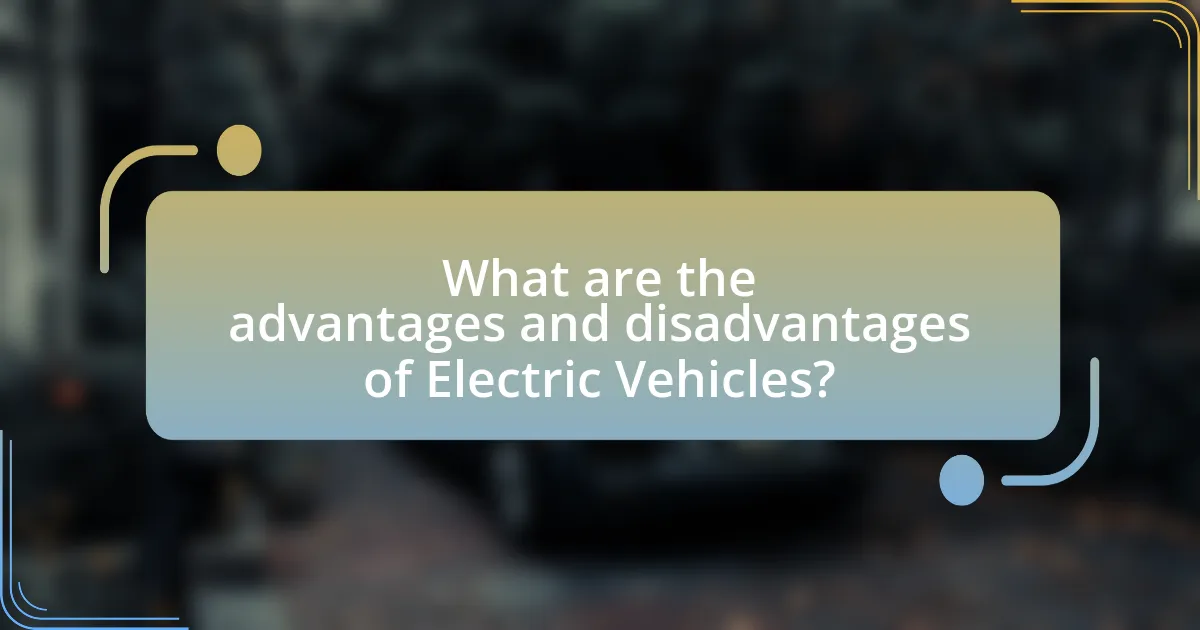
What are the advantages and disadvantages of Electric Vehicles?
Electric vehicles (EVs) offer several advantages and disadvantages. The primary advantages include lower operating costs due to reduced fuel expenses and maintenance requirements, as EVs have fewer moving parts compared to internal combustion engine vehicles. Additionally, EVs produce zero tailpipe emissions, contributing to improved air quality and reduced greenhouse gas emissions, which is supported by data from the U.S. Environmental Protection Agency indicating that EVs can significantly lower carbon footprints.
On the other hand, the disadvantages of electric vehicles include limited driving range compared to gasoline vehicles, which can lead to range anxiety among users. Charging infrastructure is still developing, making it less convenient for long-distance travel. Furthermore, the production of EV batteries raises environmental concerns due to resource extraction and potential pollution, as highlighted by studies from the International Council on Clean Transportation, which emphasize the need for sustainable battery production practices.
What benefits do Electric Vehicles provide to consumers?
Electric vehicles (EVs) provide consumers with several key benefits, including lower operating costs, environmental advantages, and enhanced convenience. The operating costs of EVs are significantly lower than those of traditional gasoline vehicles, primarily due to reduced fuel expenses and lower maintenance costs; for instance, the U.S. Department of Energy reports that electricity costs for EVs can be about half the price of gasoline per mile. Environmentally, EVs produce zero tailpipe emissions, contributing to improved air quality and reduced greenhouse gas emissions, which is crucial in combating climate change. Additionally, EVs often come with incentives such as tax credits and rebates, further lowering the overall cost of ownership. Enhanced convenience is also a benefit, as many consumers can charge their vehicles at home, eliminating the need for frequent trips to gas stations.
How do Electric Vehicles contribute to environmental sustainability?
Electric vehicles (EVs) contribute to environmental sustainability by reducing greenhouse gas emissions and decreasing reliance on fossil fuels. Unlike traditional internal combustion engine vehicles, EVs produce zero tailpipe emissions, which significantly lowers air pollution levels in urban areas. According to the U.S. Environmental Protection Agency, EVs can reduce carbon dioxide emissions by up to 50% compared to gasoline-powered vehicles, especially when charged using renewable energy sources. Additionally, the use of EVs promotes the development of cleaner energy infrastructure, as the demand for electricity can drive investments in renewable energy technologies such as solar and wind power. This transition not only mitigates climate change impacts but also enhances energy security by diversifying energy sources.
What are the cost implications of owning an Electric Vehicle?
Owning an Electric Vehicle (EV) generally incurs lower operating costs compared to traditional gasoline vehicles, primarily due to reduced fuel and maintenance expenses. EVs typically cost about 60% less to operate per mile than gasoline vehicles, with electricity prices averaging around $0.13 per kilowatt-hour, translating to approximately $4 for 100 miles of driving, compared to $12 for gasoline vehicles at $3 per gallon. Additionally, EVs have fewer moving parts, leading to lower maintenance costs, with estimates suggesting savings of about $1,000 to $1,500 over the vehicle’s lifetime. However, the initial purchase price of EVs can be higher, although federal and state incentives can offset this cost, making the overall financial implications favorable in the long term.
What challenges do Electric Vehicles face?
Electric vehicles face several significant challenges, including limited charging infrastructure, battery range anxiety, and high initial costs. Limited charging infrastructure restricts the convenience of using electric vehicles, as many regions lack sufficient charging stations, making long-distance travel difficult. Battery range anxiety arises from concerns about the distance electric vehicles can travel on a single charge, with many models offering ranges between 150 to 370 miles, which may not meet the needs of all consumers. High initial costs are another barrier, as electric vehicles typically have higher purchase prices compared to traditional gasoline vehicles, despite lower operating costs over time. These challenges hinder widespread adoption and acceptance of electric vehicles in the market.
How does charging infrastructure impact Electric Vehicle adoption?
Charging infrastructure significantly impacts Electric Vehicle (EV) adoption by addressing range anxiety and enhancing convenience for users. A robust network of charging stations increases consumer confidence, as potential EV owners are more likely to purchase a vehicle if they know they can easily access charging points. According to a study by the International Council on Clean Transportation, regions with extensive charging infrastructure see a 50% higher adoption rate of EVs compared to areas with limited access. This correlation demonstrates that the availability and accessibility of charging stations are critical factors in the decision-making process for consumers considering EVs.
What are the limitations of Electric Vehicle range?
The limitations of Electric Vehicle (EV) range primarily include battery capacity, charging infrastructure, and environmental factors. Battery capacity directly affects how far an EV can travel on a single charge; for instance, most current EVs have ranges between 150 to 370 miles, depending on the model and battery size. Charging infrastructure is another critical limitation, as the availability and speed of charging stations can significantly impact the practicality of long-distance travel. For example, while Tesla has a robust Supercharger network, other manufacturers may not have equivalent support, leading to range anxiety among users. Additionally, environmental factors such as temperature can influence battery performance; studies show that extreme cold can reduce an EV’s range by up to 40%. These factors collectively constrain the effective range of electric vehicles, making them less suitable for certain driving conditions compared to traditional gasoline vehicles.
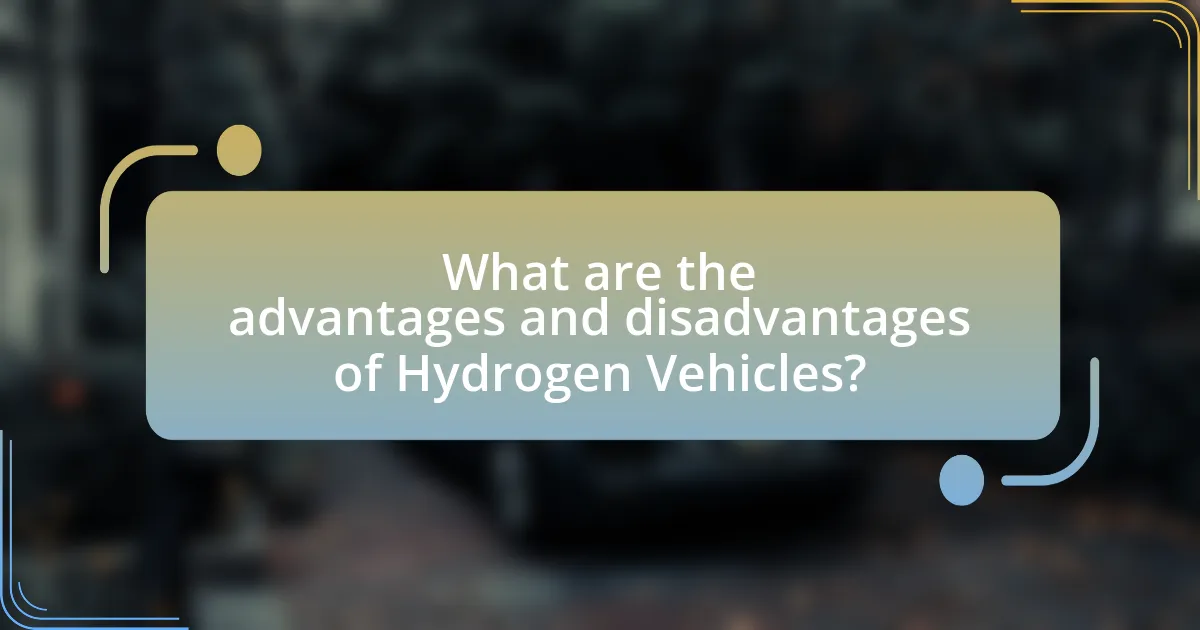
What are the advantages and disadvantages of Hydrogen Vehicles?
Hydrogen vehicles offer several advantages and disadvantages. The primary advantage is their environmental benefit; they emit only water vapor, contributing to reduced air pollution compared to traditional gasoline vehicles. Additionally, hydrogen vehicles can be refueled quickly, typically within five minutes, and they have a longer driving range than many battery electric vehicles, often exceeding 300 miles on a single tank. However, the disadvantages include limited refueling infrastructure, which restricts their widespread adoption, and the high cost of hydrogen production, particularly when derived from fossil fuels. Furthermore, the energy efficiency of hydrogen vehicles is lower than that of battery electric vehicles, as converting electricity to hydrogen and back to electricity incurs energy losses.
What benefits do Hydrogen Vehicles offer?
Hydrogen vehicles offer several benefits, including zero tailpipe emissions, fast refueling times, and longer driving ranges compared to battery electric vehicles. The absence of harmful emissions contributes to improved air quality, while hydrogen fuel cell technology allows vehicles to be refueled in approximately five minutes, similar to conventional gasoline vehicles. Additionally, hydrogen vehicles can achieve ranges of over 300 miles on a single tank, making them suitable for long-distance travel. These advantages position hydrogen vehicles as a viable alternative in the transition to sustainable transportation.
How do Hydrogen Vehicles compare in terms of refueling time?
Hydrogen vehicles typically have a refueling time of about 3 to 5 minutes, which is significantly faster than the charging time for electric vehicles. This quick refueling process is comparable to traditional gasoline vehicles, allowing drivers to resume their journeys with minimal downtime. In contrast, electric vehicles can take anywhere from 30 minutes to several hours to charge, depending on the charging station and battery capacity. This difference in refueling time highlights one of the advantages of hydrogen vehicles in terms of convenience and efficiency for long-distance travel.
What is the potential for Hydrogen Vehicles in heavy-duty applications?
Hydrogen vehicles have significant potential in heavy-duty applications due to their ability to provide long-range capabilities and quick refueling times. Heavy-duty sectors, such as trucking and public transportation, require vehicles that can operate efficiently over long distances and endure demanding workloads. Hydrogen fuel cells can deliver higher energy density compared to batteries, allowing for greater payload capacity and extended operational range. For instance, hydrogen fuel cell trucks can achieve ranges of over 500 miles on a single tank, which is crucial for long-haul logistics. Additionally, refueling a hydrogen vehicle takes approximately 15 minutes, similar to conventional diesel refueling, making it advantageous for fleet operations that prioritize uptime. The growing infrastructure for hydrogen production and distribution further supports the viability of hydrogen vehicles in heavy-duty applications, with investments from both public and private sectors aimed at expanding hydrogen refueling stations.
What challenges do Hydrogen Vehicles encounter?
Hydrogen vehicles encounter several significant challenges, primarily related to infrastructure, cost, and technology. The lack of widespread hydrogen refueling stations limits the practicality of hydrogen vehicles, as only a few regions have developed the necessary infrastructure to support them. Additionally, the production of hydrogen is often energy-intensive and costly, with most hydrogen being produced from natural gas through a process that emits carbon dioxide, which undermines the environmental benefits. Furthermore, hydrogen storage and transportation present technical challenges due to hydrogen’s low energy density and the need for high-pressure tanks, which complicate vehicle design and increase costs. These factors collectively hinder the adoption and scalability of hydrogen vehicles in the automotive market.
How does the availability of hydrogen fuel stations affect adoption?
The availability of hydrogen fuel stations significantly impacts the adoption of hydrogen vehicles. A robust network of hydrogen fuel stations enhances consumer confidence and convenience, making it easier for potential users to refuel their vehicles. For instance, a study by the International Energy Agency in 2021 indicated that regions with a higher density of hydrogen stations, such as California, experienced a corresponding increase in hydrogen vehicle sales, demonstrating a direct correlation between station availability and vehicle adoption rates.
What are the production challenges associated with hydrogen fuel?
The production challenges associated with hydrogen fuel include high costs, energy intensity, and infrastructure limitations. Producing hydrogen typically requires significant energy input, especially when using methods like electrolysis, which can be inefficient and expensive. For instance, electrolysis can cost around $4 to $6 per kilogram of hydrogen, making it less competitive compared to fossil fuels. Additionally, the current infrastructure for hydrogen distribution and storage is underdeveloped, limiting accessibility and scalability. According to the U.S. Department of Energy, only about 50 hydrogen refueling stations exist in the United States, which hampers the widespread adoption of hydrogen fuel technologies.
How do Electric Vehicles and Hydrogen Vehicles compare in terms of performance?
Electric vehicles (EVs) generally outperform hydrogen vehicles (HVs) in terms of acceleration and efficiency. EVs convert over 60% of electrical energy from the grid to power at the wheels, while HVs typically convert only about 20% of the energy stored in hydrogen. Additionally, EVs can achieve 0 to 60 mph in as little as 2.5 seconds, whereas HVs usually take longer due to the complexity of their fuel cell systems. This performance gap is supported by data from the U.S. Department of Energy, which highlights the efficiency advantages of battery electric systems over hydrogen fuel cells in real-world driving conditions.
What are the differences in acceleration and top speed?
Acceleration refers to the rate at which a vehicle increases its speed, while top speed is the maximum speed a vehicle can achieve. Electric vehicles (EVs) typically have superior acceleration due to their instant torque delivery, allowing them to reach higher speeds more quickly compared to hydrogen vehicles, which may have a delay in power delivery due to their fuel cell systems. For example, many electric cars can accelerate from 0 to 60 mph in under 3 seconds, while hydrogen vehicles generally take longer to achieve similar speeds. In terms of top speed, electric vehicles often have a higher maximum speed, with models like the Tesla Model S reaching over 200 mph, whereas hydrogen vehicles tend to have lower top speeds, often capped around 120-150 mph due to design and efficiency constraints.
How do maintenance costs compare between Electric and Hydrogen Vehicles?
Maintenance costs for Electric Vehicles (EVs) are generally lower than those for Hydrogen Vehicles (HVs). EVs have fewer moving parts, which reduces the likelihood of mechanical failures and the need for regular maintenance such as oil changes. According to a study by the U.S. Department of Energy, EVs can have maintenance costs that are about 50% lower than traditional gasoline vehicles, primarily due to their simpler drivetrain and regenerative braking systems. In contrast, HVs require more complex systems for hydrogen storage and fuel cell maintenance, which can lead to higher costs. A report from the National Renewable Energy Laboratory indicates that the maintenance costs for HVs can be significantly higher due to the need for specialized service and parts.
What are the future trends for Electric and Hydrogen Vehicles?
Future trends for electric and hydrogen vehicles indicate a significant shift towards increased adoption and technological advancements. Electric vehicles (EVs) are expected to dominate the market due to declining battery costs, with projections suggesting that battery prices could fall below $100 per kilowatt-hour by 2025, making EVs more affordable and accessible. Additionally, the global push for sustainability and stricter emissions regulations are driving investments in EV infrastructure, such as charging stations, which are anticipated to grow exponentially.
Hydrogen vehicles, while currently less prevalent, are gaining traction in specific sectors, particularly heavy-duty transportation and industrial applications. The International Energy Agency forecasts that hydrogen demand could increase significantly, with a focus on green hydrogen production from renewable sources. This trend is supported by government initiatives and partnerships aimed at developing hydrogen infrastructure, including refueling stations.
Overall, the future landscape for both electric and hydrogen vehicles will be shaped by technological innovations, regulatory frameworks, and market dynamics, leading to a more diversified and sustainable transportation ecosystem.
How is technology evolving for both Electric and Hydrogen Vehicles?
Technology is evolving for both electric and hydrogen vehicles through advancements in battery efficiency, charging infrastructure, fuel cell technology, and production methods. Electric vehicles are benefiting from improvements in lithium-ion batteries, which are becoming lighter, more energy-dense, and faster to charge, with companies like Tesla and Panasonic leading the way in battery innovation. In parallel, hydrogen vehicles are seeing progress in fuel cell technology, which is becoming more efficient and cost-effective, with manufacturers like Toyota and Hyundai investing in scalable production methods. Additionally, the development of hydrogen production from renewable sources, such as electrolysis powered by solar or wind energy, is enhancing the sustainability of hydrogen vehicles. These advancements are supported by increasing investments in infrastructure, such as charging stations for electric vehicles and hydrogen refueling stations, which are essential for widespread adoption.
What role do government policies play in the future of these vehicles?
Government policies significantly influence the future of electric and hydrogen vehicles by shaping market conditions, incentivizing adoption, and establishing regulatory frameworks. For instance, policies such as tax credits, subsidies, and grants encourage consumers and manufacturers to invest in electric and hydrogen technologies, as seen in the United States where the federal government offers tax incentives for electric vehicle purchases. Additionally, emissions regulations compel automakers to innovate and produce cleaner vehicles, with the European Union setting stringent CO2 emission targets that drive the transition towards electric and hydrogen options. Furthermore, infrastructure development policies, such as funding for charging stations and hydrogen refueling networks, are crucial for supporting the widespread adoption of these vehicles. These policies collectively create a conducive environment for the growth and sustainability of electric and hydrogen vehicle markets.
What should consumers consider when choosing between Electric and Hydrogen Vehicles?
Consumers should consider the availability of charging infrastructure and refueling stations when choosing between Electric and Hydrogen Vehicles. Electric vehicles (EVs) rely on a widespread network of charging stations, which are increasingly common in urban areas, while hydrogen vehicles depend on a limited number of hydrogen refueling stations, which can restrict their usability in many regions. Additionally, consumers should evaluate the total cost of ownership, as EVs generally have lower operating costs due to fewer moving parts and lower energy costs per mile compared to hydrogen vehicles, which often have higher fuel costs and maintenance needs. Furthermore, environmental impact is a crucial factor; while both vehicle types produce lower emissions than traditional gasoline vehicles, the source of electricity for EVs and the method of hydrogen production can significantly influence their overall carbon footprint.

